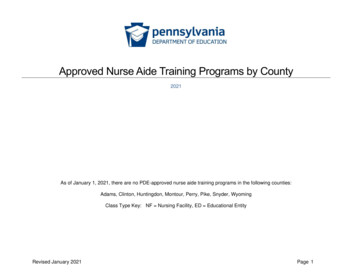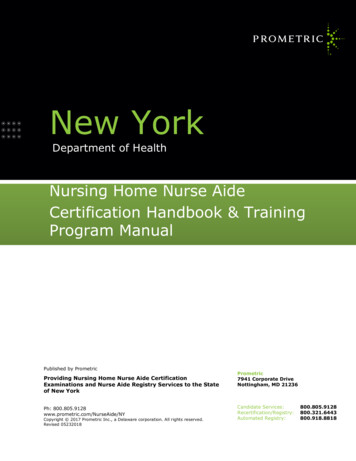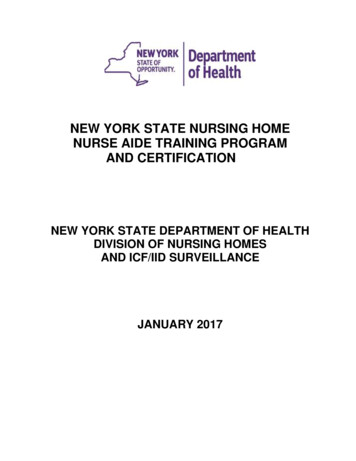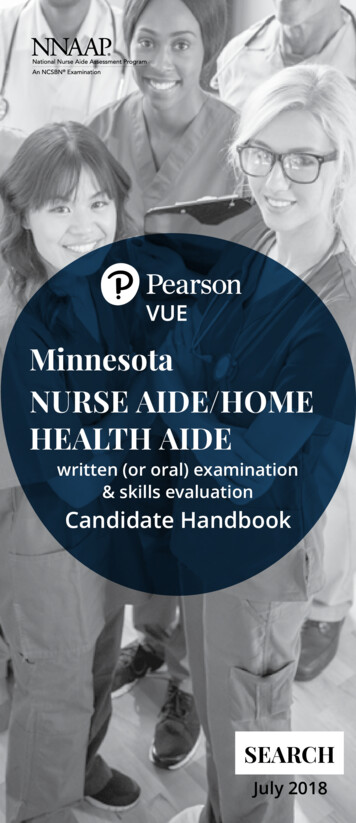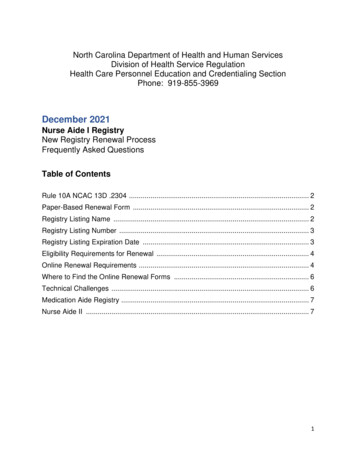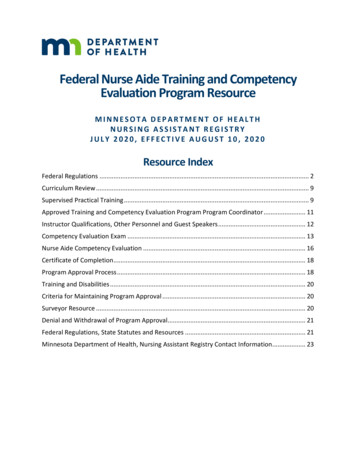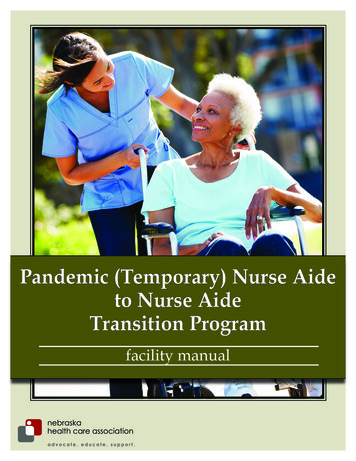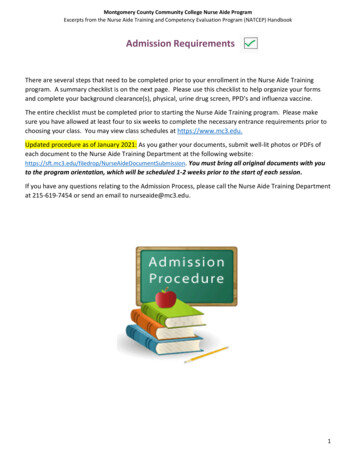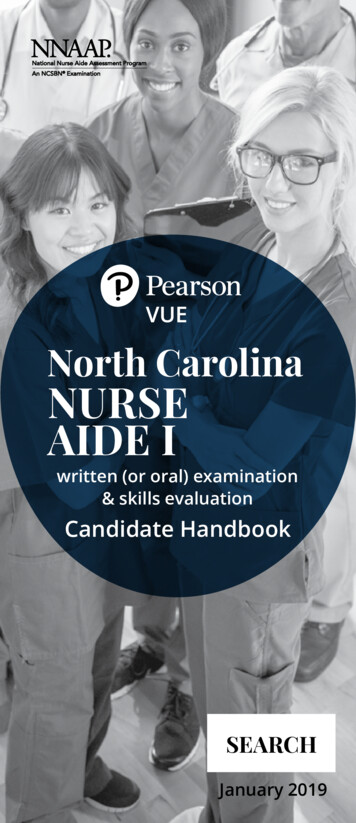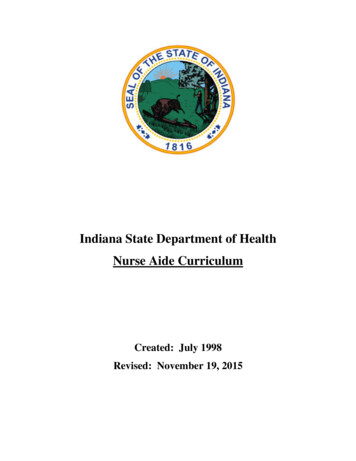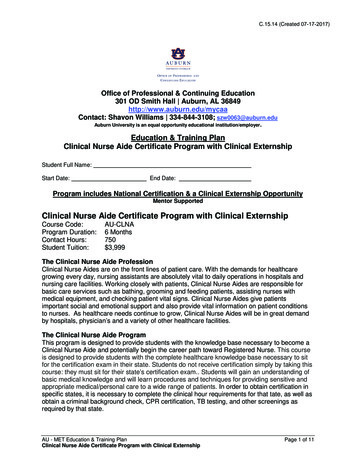
Transcription
C.15.14 (Created 07-17-2017)AUBURNOHICE OF P ROFESSIONAL ANDCONTINUING EDUCAT I ONOffice of Professional & Continuing Education301 OD Smith Hall Auburn, AL 36849http://www.auburn.edu/mycaaContact: Shavon Williams 334-844-3108; szw0063@auburn.eduAuburn University is an equal opportunity educational institution/employer.Education & Training PlanClinical Nurse Aide Certificate Program with Clinical ExternshipStudent Full Name:Start Date:End Date:Program includes National Certification & a Clinical Externship OpportunityMentor SupportedClinical Nurse Aide Certificate Program with Clinical ExternshipCourse Code:Program Duration:Contact Hours:Student Tuition:AU-CLNA6 Months750 3,999The Clinical Nurse Aide ProfessionClinical Nurse Aides are on the front lines of patient care. With the demands for healthcaregrowing every day, nursing assistants are absolutely vital to daily operations in hospitals andnursing care facilities. Working closely with patients, Clinical Nurse Aides are responsible forbasic care services such as bathing, grooming and feeding patients, assisting nurses withmedical equipment, and checking patient vital signs. Clinical Nurse Aides give patientsimportant social and emotional support and also provide vital information on patient conditionsto nurses. As healthcare needs continue to grow, Clinical Nurse Aides will be in great demandby hospitals, physician’s and a variety of other healthcare facilities.The Clinical Nurse Aide ProgramThis program is designed to provide students with the knowledge base necessary to become aClinical Nurse Aide and potentially begin the career path toward Registered Nurse. This courseis designed to provide students with the complete healthcare knowledge base necessary to sitfor the certification exam in their state. Students do not receive certification simply by taking thiscourse: they must sit for their state’s certification exam. Students will gain an understanding ofbasic medical knowledge and will learn procedures and techniques for providing sensitive andappropriate medical/personal care to a wide range of patients. In order to obtain certification inspecific states, it is necessary to complete the clinical hour requirements for that tate, as well asobtain a criminal background check, CPR certification, TB testing, and other screenings asrequired by that state.AU - MET Education & Training PlanClinical Nurse Aide Certificate Program with Clinical ExternshipPage 1 of 11
C14 (Created 09/03/15)Education and National Certifications Students should have or be pursuing a high school diploma or GED. There are several National Certification exams that are available to students whosuccessfully complete this program:o National Healthcareer Association (NHA) Certified Clinical Medical Assistant(CCMA) Examo Individual states have specific certification requirements and processesassociated with this program. Please refer to your specific state agency forcertification requirements. In addition to facilitating entry-level clinical medical assisting related positions, this courseis ideal for students interested in pursuing a future formal Nursing (LPN) or a Nursing (RN)program.Clinical Nurse Aide Detailed Course Information: Explain how laws and regulations affect the roles and responsibilities of the NursingAssistant Specialist within the health care system Demonstrate basic knowledge of effective communication skills necessary to function asa member of the health care team Demonstrate basic technical and communication skills that facilitate an optimal level offunctioning of the client, recognizing individual, cultural, and religious diversity Use procedures and techniques to promote infection control and prevent the spread ofmicroorganisms Demonstrate the ability to identify and use safety and emergency procedures Demonstrate basic knowledge of body systems, basic anatomy, common diseaseprocesses, and the aging process Demonstrate basic knowledge of vital signs and other body measurements Demonstrate basic knowledge of principles and skills of restorative nursing in providingclient care, while also using proper body mechanics Identify elements of a client’s physical environment and the client’s interaction with theirenvironment Identify proper procedures and techniques used for providing personal care to clients,including but not limited to ADLs, bathing, skin care, nutrition and feeding, elimination,range of motion, positioning, and mobility Identify psychosocial characteristics of all clients, including those with physical andcognitive impairments Demonstrate basic knowledge of delivering sensitive care to the dying client and family Identify behaviors that maintain and respect the client and client’s family rights andpromote client independence, regardless of race, religion, lifestyle, sexual preference,disease process, or ability to pay Responsibilities of the clinical medical assistant and introduction to healthcare facilities Medical terminology, anatomy and physiology, circulation of the heart and blood vessels Care & safety of patients, medical & legal aspects of care, confidentiality and HIPAA Effective verbal and non-verbal communication, interpersonal skills and human behavior Aseptic techniques, infection prevention, universal precautions, proper use and disposalof biohazards and sharps Documenting patient medical histories, updating patient medical files, vital signs anddocumentation Appling sterile dressings, preparing patients for x-rays, performing various injections,administering oral medications, instructing patients on the proper usage of medicationsAU - MET Education & Training PlanClinical Nurse Aide Certificate Program with Clinical ExternshipPage 2 of 11
C14 (Created 09/03/15)National CertificationUpon successful completion of this Auburn University Clinical Nurse Aide program, studentswould be eligible to sit for the National Healthcareer Association (NHA) Certified Clinical MedicalAssistant (CCMA) exam. Students who complete this program are encouraged to complete theclinical externship option with their program in order to gain clinical experience. Students whocomplete this program can and do sit for the NHA CCMA certification exam and are qualified,eligible and prepared to do so. Auburn University works with each student to complete theexam application, gain clinical experience and register the student to take the nationalcertification exam. Additionally, students may pursue state Certified Nursing Assistantcertification if they meet certain state requirements.Clinical Externship / Hands on Training / PracticumAlthough not a requirement of this program, once students complete the Clinical Nurse Aideprogram, they have the ability to participate in a clinical externship and/or hands on practicumso as to practice the skills necessary to perform the job requirements of a Clinical Nurse Aide.Students will be assisted with completing a resume and/or other requirements necessary towork in a hospital, physicians practice, clinic and/or with other healthcare organizations. Allstudents who complete this program are eligible to participate in an externship and will beplaced in a healthcare organization near their location. Auburn University works with nationalhealthcare organizations and has the ability to place students in clinical externship opportunitiesnationwide.Auburn University contact: If students have any questions regarding this programincluding certification and clinical externships, they should call Shavon Williams ofAuburn University at 334-844-3108 or via email at szw0063@auburn.eduNote: No refunds can be issued after the start date published in your Financial Award document.AU - MET Education & Training PlanClinical Nurse Aide Certificate Program with Clinical ExternshipPage 3 of 11
C14 (Created 09/03/15)About Auburn University!Welcome to Auburn University! Auburn University was established in 1856 as the EastAlabama Male College, 20 years after the city of Auburn's founding.OUR MISSION: The Office of Professional and Continuing Education (OPCE) makes theeducational resources of Auburn University available for non-credit education programs andconferences designed to promote lifelong learning, regardless of age, interest, or location. Ourprograms fall into five general categories: Professional Development, Certificate Programs,Personal Enrichment, Summer Youth Programs, and ationAuburn University and Pearson EducationThe Auburn University’s Office of Professional and Continuing Education eLearning programswere developed in partnership with Pearson Education to produce the highest quality, best-in class content and delivery necessary to enhance the overall student learning experience, boostunderstanding and ensure retention. Pearson Education is the premier content and learningcompany in North America offering solutions to the higher education and career trainingdivisions of colleges and universities across the country aimed at driving quality educationprograms to ensure student success. Please visit us at www.pearson.com.About Pearson EducationWelcome to Pearson. We have a simple mission: to help people make more of theirlives through learning. We are the world's leading learning company, with 40,000employees in more than 80 countries helping people of all ages to make measurableprogress in their lives. We provide a range of education products and services toinstitutions, governments and direct to individual learners, that help people everywhereaim higher and fulfil their true potential. Our commitment to them requires a holisticapproach to education. It begins by using research to understand what sort of learningworks best, it continues by bringing together people and organizations to develop ideas,and it comes back round by measuring the outcomes of our products.AU - MET Education & Training PlanClinical Nurse Aide Certificate Program with Clinical ExternshipPage 4 of 11
C14 (Created 09/03/15)Clinical Nurse Aide Program Detailed Objectives:Clinical Nurse Aide ModulesTHE HEALTHCARE SYSTEM Describe the structure of the health care system Identify variodentify various health care delivery entities Describe how health care facilities are monitored Differentiate between acute, subacute, and long-term care Describe the various members of the health care team and their rolesENSURING A PATIENT’S RIGHTS Identify the roles of a Clinical Nurse Aide Identify methods for prioritizing and planning the work day Identify ethical and legal issues related to the Clinical Nurse Aide Describe the key points of the Patients’ Bill of Rights Define the regulations and expectations associated with Residents’ RightsCOMMUNICATION AND INTERPERSONAL SKILLS Describe effective communication and interpersonal skills Identify barriers to effective communication Describe how diversity affects communication and interpersonal relationships Describe the importance of family involvement and communication related to thepatient's care Identify key points of observation, reporting, and documenting Explain the importance of military time in patient documentation Explain how prefixes and suffixes can affect the meaning of medical terms List common medical terms and abbreviationsINFECTION CONTROL List common infections present in health care facilities Describe the chain of infection Describe the body’s defenses against infections Compare asepsis and sterility Describe techniques for maintaining asepsis Identify proper hand hygiene techniques Describe the standard precautions and isolation procedures Identify proper handling techniques for infectious waste Describe the process of reporting blood or body fluid in the workplacePATIENT ENVIRONMENT, SAFETY AND EMERGENCIES Identify the basic layout and design of a client room Define general safety key points for clients in health care facilities List common accidents in facilities Explain the Material Safety Data Sheet (MSDS) Describe the body mechanic techniques that help avoid nurse and patient injury Identify common restraints used in a health care facility Describe restraint alternatives Identify the major causes of fire in the health care setting Describe fire prevention strategies Identify equipment and procedures that help ensure patient safety Identify special precautions required when oxygen is in use by a patient Identify disaster planning and evacuation proceduresAU - MET Education & Training PlanClinical Nurse Aide Certificate Program with Clinical ExternshipPage 5 of 11
C14 (Created 09/03/15) Define life-threatening situationsIdentify the role of a Clinical Nurse Aide in emergency situationsBASIC ANATOMY & BODY SYSTEMS: PART I Describe the functionality of cells, tissues, organs, and systems Identify the types of developmental and physical disabilities Describe the measures for caring for patients with developmental and physicaldisabilities Describe the basic structure and function of the cardiovascular system Identify diseases related to the respiratory system Explain the roles of the nursing assistant in caring for patients with breathing problems Describe the basic structure and function of the circulatory system Identify common disorders of the circulatory, blood, and lymphatic systems Describe the role of the nursing assistant in caring for patients with diseases of thecirculatory, blood, and lymphatic systems Describe the basic structure and function of the gastrointestinal system Identify changes in the gastrointestinal system over the course of a life span Describe the nursing assistant’s role in caring for patients with diseases of thegastrointestinal system Describe the basic structure and function of the urinary system Identify common diseases related to the urinary system Describe the role of a nursing assistant in caring for patients with diseases related to theurinary system Describe the basic structure and function of the endocrine system Identify common disorders of the endocrine system Describe the role of the nursing assistant in caring for patients with disorders of theendocrine systemBASIC ANATOMY & BODY SYSTEMS: PART II Describe the basic structure and function of the male and female reproductive systems Identify common disorders of the reproductive system Describe the role of the nursing assistant in caring for patients with reproductive systemdisorders Describe the basic structure and function of the integumentary system Identify common disorders of the integumentary system Describe the role of the nursing assistant in caring for patients with disorders related tothe integumentary system Describe the basic structure and function of the musculoskeletal system Identify common disorders of the musculoskeletal system Describe the role of the nursing assistant in caring for patients with disorders of themusculoskeletal system Describe the basic structure and function of the nervous system Identify common disorders of the nervous system Describe the role of the nursing assistant in caring for patients with nervous systemdisorders Describe the basic structure and function of the immune system Identify common disorders of the immune system Describe the role of the nursing assistant in caring for patients with communicablediseases Define growth and development throughout a person’s lifetime Describe the role of the nursing assistant in caring for patients with cognitiveimpairmentsAU - MET Education & Training PlanClinical Nurse Aide Certificate Program with Clinical ExternshipPage 6 of 11
C14 (Created 09/03/15)VITAL SIGNS AND MEASUREMENTS Identify proper techniques for obtaining vital signs of patients Describe the role of the nursing assistant in assessing and relieving patient pain Explain why it is important to record and monitor patient height and weight Identify proper techniques for measuring height and weight of ambulatory and bedriddenclients Identify proper techniques for measuring temperature via oral, rectal, axillary, aural, orgroin Describe the role of the nursing assistant in caring for patients with a fever Describe proper techniques for measuring pulse Identify factors that affect a patient’s pulse rate Describe proper techniques for measuring a patient’s respiration Identify factors that affect respiration Identify signs and symptoms that indicate respiratory problems in patients Describe proper techniques for measuring a patient’s blood pressure Identify factors that may affect a patient’s blood pressure level Describe the role of the nursing assistant in caring for patients with blood pressureproblemsBODY MECHANICS Identify and define proper body mechanics to be used for moving clients or equipment Identify positions used for repositioning patients Identify the importance of range of motion exercises Describe the proper procedures for active and passive range of motion Identify proper positioning of a patient in a bed or a chair Identify proper techniques for transferring patients Identify proper use of moving, repositioning, and lift assistive devices Identify the techniques for assisting a patient with ambulation Define priorities for care for a patient who fallsPATIENT ENVIRONMENT AND COMFORT Recognize the typical patient unit and floor layout and surroundings List the types of equipment and items found in a client room Identify how a comfortable environment contributes to a patient’s emotional and physicalwell-being Recognize the importance of an organized environment to a patient’s well- being andsafety Identify the importance of orientation of patients to their environment Identify proper bed-making techniques Describe patient orientationsPATIENT HYGIENE Identify the types of baths administered to patients Identify proper bathing techniques for patients with differing needs Identify proper techniques for providing a back massage to patients Identify proper techniques for assisting patients with perineal care Identify proper techniques for assisting patients with catheter care Describe strategies for assisting patients who use eyeglasses or hearing aids Identify proper techniques for assisting patients with oral hygiene Identify proper techniques for assisting with patient skin and nail care Identify proper techniques for assisting with patient hair care Identify proper techniques for assisting with patient shavingAU - MET Education & Training PlanClinical Nurse Aide Certificate Program with Clinical ExternshipPage 7 of 11
C14 (Created 09/03/15)SKIN CARE Recognize the importance of observing a patient's skin Identify decubitus and pressure sores Identify the patients who are at risk for developing pressure sores Differentiate between pressure and friction points Define the factors that contribute to skin breakdown for the client Recognize the pressure points on the patient’s body dependent and independent ofequipment Identify proper techniques and procedures to minimize the risk of skin injuriesNUTRITION & HYDRATION Define nutrients, carbohydrates, proteins, fats, vitamins, and minerals Identify the importance of calories and carbohydrate counting Recognize the importance of fluid balance Describe how diversity can affect dietary preferences Distinguish between the variety of special diets available to patients Describe the alternative methods used to feed patients Define the principles of supplemental snacks and fluids between meals Identify appropriate methods for measuring and recording food and fluid intakeELIMINATION, URINE & FECES Define the techniques to assist the patient with elimination Identify bowel and bladder training programs Describe the appropriate methods for measuring and recording output Identify abnormalities with elimination, incontinence, diarrhea, and constipation Describe cleaning and care of a patient's perineal area Identify proper placement and maintenance of a catheterCOGNITIVE IMPAIRMENT Define the common disorders that may cause cognitive impairments Identify the common challenges associated with dementia and Alzheimer’s disease Define the special care and safety issues concerning the cognitively impaired client Differentiate between reality orientation and validation therapy Identify the importance of calm, organized care when working with the cognitivelyimpaired clientCARE OF DYING PATIENTS Define hospice care and the needs for care Identify the physical changes as death approaches Identify the five stages of grief Define the importance of living wills or advance directives Define Limited Code and Do Not Resuscitate (DNR) orders Identify techniques for meeting the physical, psychological, spiritual, and emotionalneeds of dying clients and their families Identify the proper techniques and strategies of postmortem careAU - MET Education & Training PlanClinical Nurse Aide Certificate Program with Clinical ExternshipPage 8 of 11
C14 (Created 09/03/15)Clinical Medical Assistant ModulesCMA Module 1 – Introduction to the Clinical Medical Assisting Profession Lesson 1 The Medical Assisting Profession Reading Assignment: Chapter 1 (pp. 2-13) Lesson 2 Interpersonal Communication Reading Assignment: Chapter 2 (pp. 16-26) Lesson 3 Patient-Centered Care Reading Assignment: Chapter 3 (pp. 27-35) Reading Assignment: Chapter 4 (pp. 36-46)CMA Module 2 – The Clinical Environment Lesson 4 The Clinical Environment: Safety and the Patient Encounter Reading Assignment: Chapter 5 (pp. 48-59) Reading Assignment: Chapter 6 (pp. 60-77) Lesson 5 Medical and Surgical Asepsis Reading Assignment: Chapter 7 (pp. 78-94) Reading Assignment: Chapter 8 (pp. 95-115) Lesson 6 Pharmacology and Medication Administration Reading Assignment: Chapter 9 (pp. 116-146) Lesson 7 Vital Signs Reading Assignment: Chapter 10 (pp. 147-175) Lesson 8 Minor Surgery Reading Assignment: Chapter 11 (pp. 176-199)CMA Module 3 – Medical Specialties and Testing Lesson 9 Medical Imaging Reading Assignment: Chapter 16 (pp. 306-323) Lesson 10 Pulmonary System and Testing Reading Assignment: Chapter 18 (pp. 363-385) Lesson 11 EENT Reading Assignment: Chapter 19 (pp. 386-413) Lesson 12 Immunology and Allergies Reading Assignment: Chapter 20 (pp. 414-425) Lesson 13 Dermatology Reading Assignment: Chapter 21 (pp. 426-445) Lesson 14 Endocrinology Reading Assignment: Chapter 22 (pp. 446-456)CMA Module 4 – Medical Specialties Lesson 15 Emergency Care Reading Assignment: Chapter 23 (pp. 458-498) Lesson 16 Gastroenterology and Nutrition Reading Assignment: Chapter 24 (pp. 499-528) Lesson 17 Orthopedics and Physical Therapy Reading Assignment: Chapter 25 (pp. 529-562) Lesson 18 Obstetrics and Gynecology Reading Assignment: Chapter 26 (pp. 563-588) Lesson 19 PediatricsAU - MET Education & Training PlanClinical Nurse Aide Certificate Program with Clinical ExternshipPage 9 of 11
C14 (Created 09/03/15) Reading Assignment: Chapter 27 (pp. 589-608)Lesson 20 Neurology Reading Assignment: Chapter 28 (pp. 609-626)Lesson 21 Mental Health Reading Assignment: Chapter 29 (pp. 627-643)Lesson 22 Oncology Reading Assignment: Chapter 30 (pp. 644-654)Lesson 23 Geriatrics Reading Assignment: Chapter 31 (pp. 655-665)Lesson 24 Alternative Medicine Reading Assignment: Chapter 32 (pp. 668-678)Note: This program can be completed in 6 months. However, students will have online access tothis program for a 24-month period.MICROSOFT OFFICE Module Use an integrated software package, specifically the applications included in theMicrosoft Office suiteDemonstrate marketable skills for enhanced employment opportunitiesDescribe proper computer techniques for designing and producing various types ofdocumentsDemonstrate the common commands & techniques used in Windows desktopList the meaning of basic PC acronyms like MHz, MB, KB, HD and RAMUse WordPad and MSWord to create various types of documentsCreate headings and titles with Word ArtCreate and format spreadsheets, including the use of mathematical formulasDemonstrate a working knowledge of computer database functions, including putting,processing, querying and outputting dataDefine computer terminology in definition matching quizzesUse the Windows Paint program to alter graphicsUse a presentation application to create a presentation with both text and graphicsCopy data from one MS Office application to another application in the suiteUse e-mail and the Internet to send Word and Excel file attachmentsDemonstrate how to use the Windows Taskbar and Windows TooltipsExplain how copyright laws pertain to data and graphics posted on the InternetTake the college computer competency test after course completionNote: Although the Microsoft Office Module is not required to successfully complete this program,students interested in pursuing free Microsoft MOS certification may want to consider completing thisMicrosoft Office Module at no additional cost.AU - MET Education & Training PlanClinical Nurse Aide Certificate Program with Clinical ExternshipPage 10 of 11
C14 (Created 09/03/15)System Requirements:Windows Users: Windows 8, 7, XP or Vista 56K modem or higher Soundcard & Speakers Firefox, Chrome or Microsoft Internet ExplorerMac OS User: Mac OS X or higher (in classic mode) 56K modem or higher Soundcard & Speakers Apple SafariiPad Users: Due to Flash limitations, eLearning programs are NOT compatible with iPadsScreen Resolution: We recommend setting your screen resolution to 1024 x 768 pixels.Browser Requirements: System will support the two latest releases of each browser. When using older versionsof a browser, users risk running into problems with the course software.o Windows Users: Mozilla Firefox, Google Chrome, Microsoft Internet Explorero Mac OS Users: Apple Safari, Google Chrome Mozilla FirefoxSuggested Plug-ins: Flash Player Real Player Adobe Reader JavaAU - MET Education & Training PlanClinical Nurse Aide Certificate Program with Clinical ExternshipPage 11 of 11
The Clinical Nurse Aide Program . This program is designed to provide students with the knowledge base necessary to become a Clinical Nurse Aide and potentially begin the career path toward Registered Nurse. This course is designed to provide students with the complete healthcare knowledge base necessary to sit
